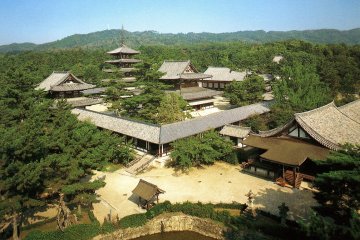
Hōryūji Temple in Nara
Tony MarianiHoryuju, Buddhism, Nara, Oldest wooden structures in the world.

Japan is filled with a wide variety of temples, ranging from modest to opulent and from massive to small. Horyuji in Nara stands out from the rest as it is, not only, one of Japan’s oldest temples, but also home to the world’s oldest surviving wooden structures, making it a one-of-a-kind destination.
Horyuji’s conception began with Emperor Yomei who desired to build a temple and image of Buddha as a form of prayer to combat an illness he was suffering from. Tragically, Emperor Yomei passed away before he could accomplish this goal. Despite this misfortune, the emperor’s wishes lived on with his son. Prince Shotoku honored his father and established the temple in 607. Soon after, in 670, a fire destroyed multiple temple buildings, which were quickly rebuilt by the early 8th century. However, some historians debate whether this fire actually occurred.
Given Prince Shotoku’s profound influence in the early introduction of Buddhism to Japan, Horyuji has stood as a faithful beacon of the religion for centuries and is a preserved storyteller of that history with over 2,300 important cultural and historical structures and articles onsite.
Horyuji is recognized as a UNESCO World Heritage Site and is the first site to receive this designation in Japan. The temple is divided into two precincts—Western (Saiin Garan) and Eastern (Toin Garan). The Western Precinct is centered around Horyuji’s Five-Story Pagoda and Main Hall (Kondo), while the Eastern Precinct is centered around the Hall of Visions (Yumedono). Walk through the expansive 14.6-hectare temple grounds, admire some of the earliest Buddhist structures in Japan, and immerse yourself in the historic atmosphere. Listed below are the must-see spots at Horyuji. Aside from these highlights, the temple is filled with noteworthy buildings, such as a Bell Tower, a library, halls, gates, and more. Be sure to dedicate multiple hours to the magnificent temple.
Chumon marks the entrance to the inner temple complex of the Western Precinct, which is where the Main Hall and Five-Story Pagoda are located. This two-story, four-bay structure is flanked by Japan’s two oldest Kongo Rikishi statues, or guardian deities.
The Main Hall is one of the world’s oldest surviving wooden structures. The remarkable two-story building is decorated with dragon sculptures and features a tiled hip and gable roof typical of Asuka Period architecture. Inside, the hall contains Horyuji’s most important treasures, including elaborate murals of Buddha and bodhisattvas, bronze Buddha statues of Shaka Nyorai (historical Buddha), Yakushi Nyorai (Buddha of healing and medicine), and Amida Nyorai (Buddha of the Pure Land), and wooden statues of the Four Heavenly Kings (Shitenno).
Similar to the Kondo, the Five-Story Pagoda is one of the world’s oldest surviving wooden structures and dates back to the Asuka Period, reflecting a traditional design of that time. The 32.5-meter-tall pagoda houses a collection of clay statues dating back to 711 that depict four scenes from Buddha’s life.
Located north of the Main Hall and Five-Story Pagoda is the Great Lecture Hall. This one-story building was built in 990 after the original structure was destroyed by a fire. The lecture hall enshrines a seated statue of Yakushi Nyorai flanked by two bodhisattvas, Nikko and Gakko.
East of the Kondo is the Gallery of Temple Treasures, which is a recent addition completed in 1998. The two buildings contain important Buddhist relics, including Yumetagai Kannon, portraits of Prince Shotoku, a Kudara Kannon statue, ancient masks, and more.
Yumedono, located in the Eastern Precinct, is an easily recognizable octagon-shaped structure dedicated to Prince Shotoku. The building is home to a life-sized, gold-foiled statue of Prince Shotoku called Kuse Kannon. This mysterious statue was wrapped in silk and hidden for centuries to preserve its power of saving people from suffering. However in 1884, the statue was unveiled, and is now open to the public twice a year in spring and autumn.
Take the Yamatoji Line from JR Nara Station to Horyuji Station (12-13 minutes). From Horyuji Station, the temple is about a 20-minute walk or a 5-minute bus ride via local bus number 72. Alternatively, you can take bus number 97 from JR Nara or Kintetsu Nara Station to Horyuji-mae bus stop (about one hour), which is a few minutes walk from the temple.

Horyuju, Buddhism, Nara, Oldest wooden structures in the world.

Horyu-ji Temple's Sai-in (Western) Precinct was established by Prince Shotoku (574-622) for the purpose of training Buddhist priests. It was a big project that announced the dawn of a new era of Japan as a Buddhist country.
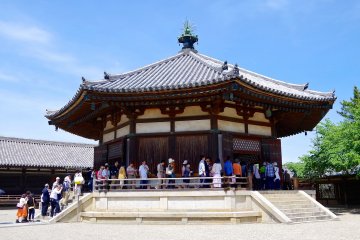
Among the hundreds of statues in Horyu-ji Temple, the most mysterious statue there might be Guze (Kuse) Kannon.
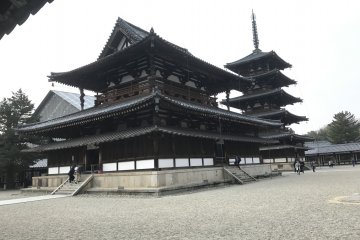
Let the hundreds and hundreds of years of this sacred location refresh your soul... Hōryū-ji, a place not to miss if you visit Nara!

A visit to Horyuji Temple, Nara: Art, history, nature and lovely food around Japan.
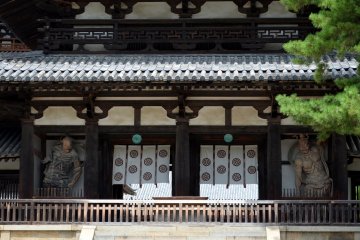
Nara's Horyuji Temple, with wooden buildings over 1,300-year-old, was the first World Heritage site in Japan.

Horyu-ji Temple in Ikaruga Town, Nara is famous for being the oldest wooden building in the world. Under the name of 'Buddhist Monuments in the Horyu-ji Area', the temple was registered as World Cultural Heritage site in 1993.
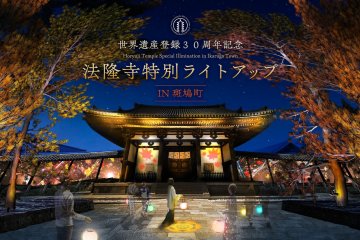
A special event this October brings colorful illuminations to Nara's Horyuji Temple, celebrating the 30th anniversary of Horyuji's registration as a World Heritage Site.


Mr Q is located on the ground floor of a bar that is located within a Showa era (1925-1989) arcade containing snack bars, ramen restaurants and jazz bars.

A limited-time afternoon tea event at the JW Marriott Hotel Nara celebrates the release of the movie "Peter Rabbit 2: The Runaway". Peter's Afternoon Tea Buffet will serve up a range of sweet and savory dishes incorporating locally grown fruits and vegetables.

Yakushiji Temple is regarded as one of the oldest and most important temples in Japan, which is no surprise given its impressive status. The temple is recognized as a UNESCO World Heritage Site, the headquarters of the Hosso Sect of Buddhism, and one of the Seven Great Temples of Nara. Emperor Tenmu founded the temple in 680 and dedicated it to Yakushi Nyorai (the Buddha of Healing) to aid his wife—who later became Empress Jito—in her recovery from an illness. Yakushiji was originally located in Fujiwara-kyo, but later moved to Nara in 718, where it still stands today. Although all of the original temple structures, except the East Pagoda, were lost to fires, the temple’s present-day reconstructions accurately reflect its traditional and grand design. Today, visitors and students of Buddhism flock to the site for spiritual learning, healing, and prayer. In addition to the main temple buildings listed below, Yakushiji is home to Yasumigaoka Hachimangu Shrine, other traditional halls, and Buddhist artwork and artifacts. Do not pass up the opportunity to visit Yakushiji’s distinguished temple grounds and immerse yourself in the sacred and educational atmosphere.

Toshodaiji Temple, located just north of Yakushiji Temple in Nara, is a significant site related to the development of Buddhism in Japan and signifies a connection between Japanese and Chinese cultures. The prestigious temple was founded in 759 by the Chinese monk Ganjin, who traveled to Japan in 754 after being asked by the emperor to help train monks and improve Japanese Buddhism. After retiring, Ganjin was granted land and consequently, established Toshodaiji to continue teaching Chinese Buddhist principles. Today, the temple is recognized as a UNESCO World Heritage Site. Without a doubt, Toshodaiji’s most impressive structure is its Kondo, or Main Hall, which was reopened to visitors in 2009 after nearly ten years of reconstruction work. The one-story Kondo, situated directly behind the Nandai-mon (Southern Great Gate), is the epitome of early Japanese-Buddhist architecture with a tiled sloping roof, seven bays, columns, and dark wood tones. Due to the building’s columned facade, it is often compared to the Parthenon. Inside, the hall houses principal Buddhist statues, which are designated as National Treasures. Standing before the hall, you cannot help but be swept away by its commanding presence. Near the Kondo is the Kodo Lecture Hall. This structure was originally built as an administrative building for the Nara Imperial Palace, but later relocated to Toshodaiji after it was gifted to Ganjin. Today, the hall is the only surviving building of the palace, and thus, a historically significant and rare part of the temple. Another prominent temple building is the Miei-do, which enshrines a famous wooden sculpture of Ganjin that his disciples created using hollow-core, dry-lacquer techniques. The exclusive building is only open to the public for a few days a year around June 6th. For all other days, visitors can view a replica of the statue, which was made on the 1,250th anniversary of Ganjin’s death, on display at the nearby Kaizando. In the eastern woods of the precinct lies Ganjin’s grave, one of the most tranquil areas of the temple. Follow a nature-laden path through thick foliage and then cross over a small bridge into the peaceful haven. Toshodaiji is also home to monk sleeping quarters, storehouses for sutras and treasures, and the Koro (Shariden), which is the site of the Uchiwamaki Ceremony, or Fan Scattering Festival, on May 19. Be sure to visit this remarkable temple and walk the footsteps of one of the most influential Chinese monks of Japanese Buddhism.

Ikaruga-cho is a town in Nara Prefecture. It’s most famous for Horyuji Temple, home of the world’s oldest wooden buildings.